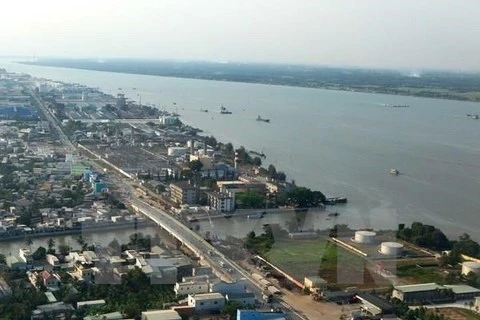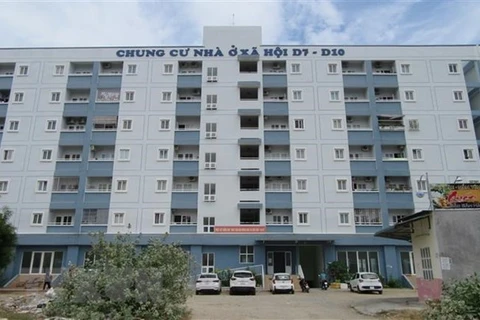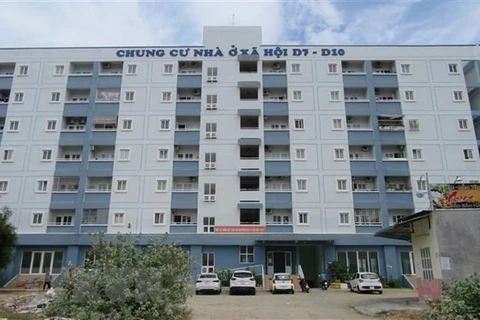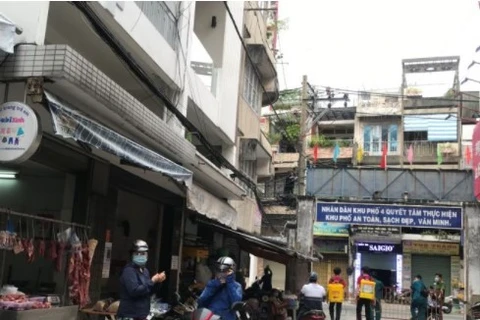HCM City (VNS/VNA) - Provinces in the southeastern region are making efforts to build more social housing units to address the housing needs of migrant workers from other parts of the country.
The Ho Chi Minh City People Committee has directed the Department of Construction to work with districts' People Committees to complete a housing development project in the 2021-2030 period and submit plans to the city People's Committee for approval.
According to the plan, the city will complete pilot software to manage the planning, resources and construction of a central area covering 930ha.
The city government will improve relations between the Department of Construction and district People's Committees and Thu Duc city in the granting of construction permits and management of technical infrastructure.
The city department wants to increase the average housing area per person to 23.5 square metres by 2025 from the current 20.65 square metres.
To reach the target, the city will need nearly 800.9ha for commercial housing and 173.5ha for social housing at a cost of 239.7 trillion VND (10.6 billion USD) and 937.7 trillion VND (41.6 billion USD), respectively.
Housing projects under construction will be sped up, and new houses and apartment buildings along major public transport axes and areas with good technical infrastructure will be given construction priority.
The city will encourage investment by developers in five social housing projects with 3,955 apartments in districts 7 and Binh Tan and five more with 4,352 apartments in Thu Duc city.
The demand for buying or renting social or low-cost housing is high as 1.9 million people in the city live in boarding houses.
Of the 280,000 workers at 17 export processing and industrial parks, only 16 percent live in housing areas for staff, while up to 60 percent live in rented rooms in boarding houses.
Besides HCM City, the country’s largest economic hub, Binh Duong and Dong Nai provinces are home to many industrial parks and export processing zones with millions of migrant workers.
The supply of social housing apartments in localities is still limited, but demand is high, which has led to price increases.
Binh Duong province developed a social housing plan more than 10 years ago, with apartments for workers and social welfare beneficiaries such as poor households, built by the Becamex Investment and Industrial Development Corporation (Becamex IDC).
However, so far, the number of social housing apartments only meets about 20 percent of the demand among low-income workers.
Twenty-three social housing projects were completed and put into use in the 2011-15 period, with a total floor area of nearly 431,500sq.m for more than 9,600 apartments, meeting the housing needs of 37,500 people.
In the past five years, there have been 17 more approved projects and another proposed project, with total floor area of about 1.3 million square metres.
Becamex IDC offers its social housing apartments at preferential prices ranging from 100 million VND (4,378 USD) to 200 million VND (8,755 USD) per 30sq.m apartment, and also provides preferential loans to homebuyers.
The supply of this kind of apartment only partly meets the needs of migrant workers and low-income earners in the province. Hundreds of thousands of people who temporarily reside in the province have not been able to rent or buy a social housing apartment.
Meanwhile, Dong Nai province has just completed and put into use nearly 3,500 social housing units, including 1,600 units for workers.
The province is implementing 13 more social housing projects on 59.3ha for nearly 8,200 housing units, including three projects for workers with about 2,900 units.
This number is still too small compared to the housing needs of 410,000 workers in the province.
To deal with the serious shortage of social housing for workers, the province has issued a Resolution on housing development in the 2021-30 period, targeting 6,000 social housing units.
Binh Duong plans to build about one million more low-cost housing units for workers and low-income earners in the coming years.
The province has also proposed that the Government lend about 10 trillion VND (437.5 million USD) from the central government budget and mobilise other capital sources for the plan.
In recent meetings with the two provinces’ authorities, Minister of Construction Nguyen Thanh Nghi said that Binh Duong should diversify capital sources for social housing projects.
Dong Nai needs to pay more attention to the quality of investment rather than the quantity, and review vacant land plots in industrial zones to build affordable accommodations for workers.
Together with the business community, localities should call on State-owned enterprises to take the lead in social housing development, he said.
In the coming time, the Government will provide a financial support package from the State budget to help home developers and homebuyers access preferential loans for social housing development, he added./.
The Ho Chi Minh City People Committee has directed the Department of Construction to work with districts' People Committees to complete a housing development project in the 2021-2030 period and submit plans to the city People's Committee for approval.
According to the plan, the city will complete pilot software to manage the planning, resources and construction of a central area covering 930ha.
The city government will improve relations between the Department of Construction and district People's Committees and Thu Duc city in the granting of construction permits and management of technical infrastructure.
The city department wants to increase the average housing area per person to 23.5 square metres by 2025 from the current 20.65 square metres.
To reach the target, the city will need nearly 800.9ha for commercial housing and 173.5ha for social housing at a cost of 239.7 trillion VND (10.6 billion USD) and 937.7 trillion VND (41.6 billion USD), respectively.
Housing projects under construction will be sped up, and new houses and apartment buildings along major public transport axes and areas with good technical infrastructure will be given construction priority.
The city will encourage investment by developers in five social housing projects with 3,955 apartments in districts 7 and Binh Tan and five more with 4,352 apartments in Thu Duc city.
The demand for buying or renting social or low-cost housing is high as 1.9 million people in the city live in boarding houses.
Of the 280,000 workers at 17 export processing and industrial parks, only 16 percent live in housing areas for staff, while up to 60 percent live in rented rooms in boarding houses.
Besides HCM City, the country’s largest economic hub, Binh Duong and Dong Nai provinces are home to many industrial parks and export processing zones with millions of migrant workers.
The supply of social housing apartments in localities is still limited, but demand is high, which has led to price increases.
Binh Duong province developed a social housing plan more than 10 years ago, with apartments for workers and social welfare beneficiaries such as poor households, built by the Becamex Investment and Industrial Development Corporation (Becamex IDC).
However, so far, the number of social housing apartments only meets about 20 percent of the demand among low-income workers.
Twenty-three social housing projects were completed and put into use in the 2011-15 period, with a total floor area of nearly 431,500sq.m for more than 9,600 apartments, meeting the housing needs of 37,500 people.
In the past five years, there have been 17 more approved projects and another proposed project, with total floor area of about 1.3 million square metres.
Becamex IDC offers its social housing apartments at preferential prices ranging from 100 million VND (4,378 USD) to 200 million VND (8,755 USD) per 30sq.m apartment, and also provides preferential loans to homebuyers.
The supply of this kind of apartment only partly meets the needs of migrant workers and low-income earners in the province. Hundreds of thousands of people who temporarily reside in the province have not been able to rent or buy a social housing apartment.
Meanwhile, Dong Nai province has just completed and put into use nearly 3,500 social housing units, including 1,600 units for workers.
The province is implementing 13 more social housing projects on 59.3ha for nearly 8,200 housing units, including three projects for workers with about 2,900 units.
This number is still too small compared to the housing needs of 410,000 workers in the province.
To deal with the serious shortage of social housing for workers, the province has issued a Resolution on housing development in the 2021-30 period, targeting 6,000 social housing units.
Binh Duong plans to build about one million more low-cost housing units for workers and low-income earners in the coming years.
The province has also proposed that the Government lend about 10 trillion VND (437.5 million USD) from the central government budget and mobilise other capital sources for the plan.
In recent meetings with the two provinces’ authorities, Minister of Construction Nguyen Thanh Nghi said that Binh Duong should diversify capital sources for social housing projects.
Dong Nai needs to pay more attention to the quality of investment rather than the quantity, and review vacant land plots in industrial zones to build affordable accommodations for workers.
Together with the business community, localities should call on State-owned enterprises to take the lead in social housing development, he said.
In the coming time, the Government will provide a financial support package from the State budget to help home developers and homebuyers access preferential loans for social housing development, he added./.
VNA
























